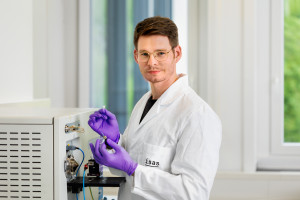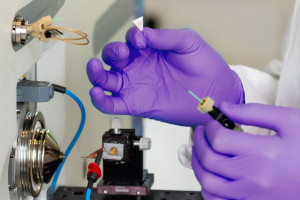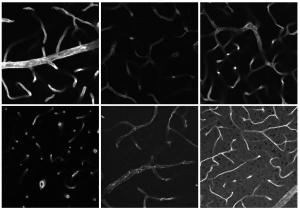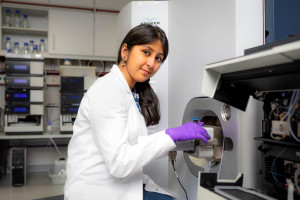Dortmund, 7th February 2024
Whenever researchers want to investigate complex samples using mass spectrometers – blood samples from patients, for example – they come up against an obstacle. The substances to be analysed therein are often fundamentally different. For instance, some have a polar chemical structure, while others are non-polar. To date, in practice this means that researchers are not able to detect the substances in one single processing step and instead have to spend time evaluating the samples twice. But an ISAS researcher has now developed a method with which even slightly polar substances – the important biomarker cholesterol, for instance – can be detected at the same time as polar biological substances in a common mass spectrometric analysis.
Mass spectrometry is a central detection technique in medical research, as it makes it possible to accurately examine which biological substances are contained in urine, blood or saliva samples, for example. For this purpose, the ingredients – usually molecules – are transferred into the gas phase and ionised, then accelerated by an electric field and separated according to their mass-to-charge ratio. From the signals generated, it is possible to read off what was contained in the analyte solution and in what quantities.
“For liquid biological samples, primarily two methods have become established: electrospray ionisation and plasma ionisation techniques,” says Dr Daniel Foest, researcher in the Miniaturisation research group. With electrospray ionisation, the sample is mixed with a solvent and directed through a metal capillary with an energised tip, which – with the help of a counter electrode – builds up an electric field. The solution escaping from the tip of the needle then disintegrates inside the same into a cloud of fine droplets, which electrostatically repel each other – this is known as the Taylor cone. The droplets disintegrate into ever smaller units, until only hovering, ionised analyte molecules are left and these are directed into the mass spectrometer. With plasma ionisation, in contrast, the solution is evaporated in a thermospray at a temperature of several hundred degrees and subsequently ionised by the plasma. Loosely speaking, with electrospray ionisation the ions are generated in the liquid phase, while with plasma ionisation, this occurs in the gas phase.

Dr Daniel Foest is a chemist and researcher in the Miniaturisation working group. He is holding a paper with a liver sample that he is analysing on the mass spectrometer.
© ISAS/ Hannes Woidich
“A complex sample such as a blood or liver sample contains many substances that are soluble in water and thus polar, for which electrospray ionisation works well,” the 38-year-old explains. But where there is any doubt, it must be assumed that the sample also contains non-polar lipids, for which it is plasma ionisation that has proven its worth. In other words: “When we examine a complex sample using electrospray mass spectrometry, we never have the full picture because we see only one part of the substances that are in there.
Duplicate analyses take time
For this reason, researchers often have to duplicate their examinations of complex samples: first using the electrospray, then repeating the process with plasma ionisation. “This takes a lot of time,” says the chemist. As the mass spectrometer needs to be refitted and recalibrated between the two analysis runs, it can easily take more than half a day to measure one single complex sample. “Or you set up two devices, which may be too expensive, depending on where you are working.” A mass spectrometer can easily cost several hundred thousand euros.
This is why medical researchers have spent decades looking for a way to unify the two methods, says Foest. But as they require contrasting conditions, this has always proved difficult until now. “On the one hand, one must not use heat with electrospray ionisation, as the aerosols in the Taylor cone would evaporate too quickly and the spraying process would be interrupted. On the other hand, we need heat for plasma ionisation,” says Foest, who came to ISAS for the first time around ten years ago in order to complete his bachelor’s thesis for the chemistry degree he was studying for at a university of applied sciences. He liked the work so much that he decided to work towards doing a PhD at the Institute. Foest switched to the University of Wuppertal and returned to ISAS time and time again during his master’s programme.
Plasma-based ionisation simplifies cholesterol analysis
During his dissertation, the junior researcher noticed something. He was examining a liver sample on the mass spectrometer using paper spray ionisation, a variant of electrospray in which paper replaces the metal capillary otherwise used. “I was performing a long-duration measurement and when the paper eventually ceased spraying because the solvent ran out, I saw a corona discharge being formed, i.e. plasma-based ionisation. To my knowledge, this had never been observed before,” says Foest, who published his discovery in the specialist journal Analytica Chimica Acta.
Foest, D., Knodel,A., Brandt, S., Franzke, J.
(2022). Coupling paper spray ionization with the flexible microtube plasma for the determination of low polar biomarkers in mass spectrometry. Analytica Chimica Acta, 1201, 339619. https://doi.org/10.1016/j.aca.2022.339619.

In paper spray ionization, a variant of electrospray, paper replaces the metal capillary typically used. The flexible microtube plasma (shown at the front right) used in combination enables the mass spectrometric analysis of substances that cannot generally be analyzed using paper spray.
© ISAS/Hannes Woidich
The signals that Foest observed were initially only weak, but the doctoral candidate found that he was able to amplify them by adding a plasma source developed during miniaturisation to the paper spray. “This also helped to clarify the ionisation process, as part of the sample is deposited at the inlet of the mass spectrometer and is desorbed again to be subsequently ionised by the plasma,” he explains.
This works very well with cholesterol, for example, as was tested by Foest. This molecule is incredibly important in medicine because it is involved in numerous cell processes and serves as a biomarker in diagnosing many illnesses, from cardiovascular diseases through to prostate cancer. Being a largely non-polar compound, analysing cholesterol with conventional electrospray ionisation for mass spectrometry has provided only poor results in the past. Other volatile compounds can also be analysed using this method as potential biomarkers for various cancers.
Combination simplifies the analysis of slightly polar substances such as cholesterol
In the months of work that followed, Foest developed a procedure in which complex samples are first analysed using a mass spectrometer and electrospray ionisation then, in the same processing step, with a powerful flexible microtube plasma (FμTP). With this procedure, a cooling gas keeps the electrospraying process to a low temperature and a heating element assists in the subsequent plasma ionisation step. In the hybrid ionisation method developed by Foest and his colleagues in the Miniaturisation research group, polar and non-polar lipids are now detected “simultaneously”, says the chemist. In addition to cholesterol, it is now possible to detect other slightly polar substances, such as diglycerides and triglycerides (neutral fats), using hybrid ionisation. “This means we are now able to analyse all molecules in a single measurement; previously, these had to be measured using two different approaches.”
Foest completed his doctorate at the end of 2023 and continues to work on analytics for health research at ISAS. “I really do like research that has medical applications in mind.”
(Ute Eberle)








